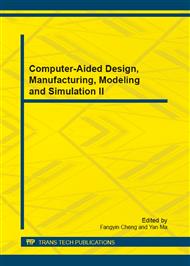p.543
p.551
p.556
p.561
p.566
p.571
p.576
p.581
p.586
Heavy Metal Accumulation Characteristics of 3 Pioneer Plants in Wasteland of Coalmine Tailing in Mingshan
Abstract:
Accumulation characteristics on 7 heavy metals of 3 indigenous pioneer plants (Ageratum conyzoides, Comnyza canadensis, Miscanthus floridulus) & their rhizosphere soil was investigated in wasteland of coalmine tailing in Mingshan. The chief results were as follows: (1) soil pollution was mainly due to the compound Cd-Mn-Cu, of which Cd average content of soil was 2.052 mg/kg (between 0.759 to 3.109mg/kg) and much higher than the national secondary standard of GB 15618-1995 (Environmental quality standard for soils in China), and of which Mn average content of soil was 421.215mg/kg (between 387.057 to 488.660 mg/kg) and serious pollution, and of which Cu content was 91.281mg/kg (between 39.522 to 270.308mg/kg) and had certain pollution but not so serious; (2) the absorption and accumulation ability to the Ni, Cd, Cu, Pb, Zn, Mn and Cr of soil heavy metal among 3 indigenous pioneer plants & their different parts of the plant such like the root, stem, and leaf was not the same, on the whole had the synergistic and antagonistic effect for 7 ele-ments in 3 plants, of whom Ageratum conyzoides had an obvious synergistic action for Ni, Cu, Pb, Zn and Mn absorption and was beneficial to suck up further elements from the soil in wasteland of coalmine tailing, and of Comnyza canadensis and Miscanthus floridulus had different synergistic and antagonistic effect for 7 elements, especially Comnyza canadensis and Miscanthus floridulus were the Cd hyperaccumulator plants. (3) Heavy metal content of Miscanthus floridulus in the body was the lowest, and its enrichment coefficient, translocation factor was obviously lower than that of the other 2 plants too, so absorption mechanisms to heavy metal of Miscanthus floridulus could been believed as excluders, relatively Mn, Pb, Zn, Cu and Ni content in the over-ground parts of Comnyza canadensis and Miscanthus floridulus & their enrichment coefficient, translocation factor was rather high, and their absorption mechanisms to heavy metal belonged to accumulators.
Info:
Periodical:
Pages:
566-570
Citation:
Online since:
December 2012
Authors:
Price:
Сopyright:
© 2013 Trans Tech Publications Ltd. All Rights Reserved
Share:
Citation:


